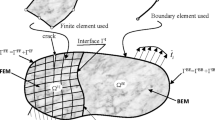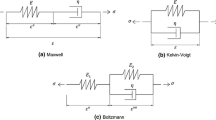Abstract
The boundary element method (BEM) has proven to be an efficient approach for crack analysis in fracture mechanics, while its versatility in application to crack problems of complex structures with irregular boundaries deserves further attention. In this study, to improve the applicability to complex crack analysis, a cracked superelement is first established with BEM to model the near-crack region, and the crack problem is then solved within the frame of finite element method (FEM). The stiffness matrix of the cracked superelement is formulated using the spline fictitious boundary element method (SFBEM) based on the Erdogan fundamental solutions for an infinite plane with a single crack. The proposed superelement is further incorporated into a finite element mesh to simulate the behaviour of the crack zone, and the governing equation of the crack problem is finally established and solved using the typical procedure of FEM. After obtaining the nodal displacements of the superelement, the stress intensity factors (SIFs) of crack tips can be obtained by a backward analysis with SFBEM. The accuracy and efficiency of the proposed SFBEM–FEM coupling method are demonstrated by two numerical examples involving a rectangular plate with a central crack and a square plate with 100 horizontal cracks. The present approach is further applied to the analysis of the SIFs of multiple cracks exposed in a steel anchorage box for a hanger of a suspension bridge, which indicates the merging of the cracked superelements to the commercial FEM software is computationally efficient for the analysis of complex structures with multiple cracks.















Similar content being viewed by others
References
Shen DW, Fan TY (2003) Exact solutions of two semi-infinite collinear cracks in a strip. Eng Fract Mech 70(6):813–822
Busari YO, Ariri A, Manurung YH, Sebayang D, Leitner M, Zaini WS, Kamilzukairi MA, Celik E (2020) Prediction of crack propagation rate and stress intensity factor of fatigue and welded specimen with a two-dimensional finite element method. Mater Sci Eng 834(1):12008
Shi JX, Chopp D, Lua J, Sukumar N, Belytschko T (2010) Abaqus implementation of extended finite element method using a level set representation for three-dimensional fatigue crack growth and life predictions. Eng Fract Mech 77(14):2840–2863
He D, Guo Z, Ma H (2021) Penny-shaped crack simulation with a single high order smooth boundary element. Eng Anal Bound Elem 124:211–220
Belytschko T, Gracie R, Ventura G (2009) A review of extended/generalized finite element methods for material modeling. Modell Simul Mater Sci Eng 17(4):043001
De Luycker E, Benson DJ, Belytschko T, Bazilevs Y (2011) X-FEM in isogeometric analysis for linear fracture mechanics. Int J Numer Methods Eng 87(6):541–565
Banerjee PK, Butterfield R (1981) Boundary element methods in engineering science. McGraw-Hill, London, p 451P
Xie GZ, Zhang DH, Meng FN, Du W, Zhang J (2017) Calculation of stress intensity factor along the 3D crack front by dual BIE with new crack front elements. Acta Mech 228(9):3135–3153
Gu Y, Zhang CZ (2020) Novel special crack-tip elements for interface crack analysis by an efficient boundary element method. Eng Fract Mech 239:107302
Erdogan F (1962) On the stress distribution in a plate with collinear cuts under arbitrary loads. Proceedings of the 4th U.S. National Congress of Applied Mechanics, pp 547–553
Su C, Zheng C (2012) Probabilistic fracture mechanics analysis of linear-elastic cracked structures by spline fictitious boundary element method. Eng Anal Bound Elem 36(12):1828–1837
Xu Z, Su C, Guan ZW (2018) Analysis of multi-crack problems by the spline fictitious boundary element method based on Erdogan fundamental solutions. Acta Mech 229(8):3257–3278
Xu Z, Chen M, Su C (2019) Dynamic analysis of multi-crack problems by the spline fictitious boundary element method based on Erdogan fundamental solutions. Eng Anal Bound Elem 107:3257–3278
Frangi A, Novati G (2003) BEM-FEM coupling for 3D fracture mechanics applications. Comput Mech 32(4–6):415–422
Helldoerfer B, Haas M, Kuhn G (2008) Automatic coupling of a boundary element code with a commercial finite element system. Adv Eng Softw 39(8):699–709
Nikishkov G (2010) Combined finite- and boundary-element analysis of SCC crack growth. ISCMI Ii EPMESC Xii 1233:747–752
Rungamornrat J, Mear ME (2011) SGBEM-FEM coupling for analysis of cracks in 3D anisotropic media. Int J Numer Methods Eng 86(2):224–248
Nguyen TB, Rungamornrat J, Senjuntichai T, Wijeyewickrema AC (2015) FEM-SGBEM coupling for modeling of mode-I planar cracks in three-dimensional elastic media with residual surface tension effects. Eng Anal Bound Elem 55:40–51
Zienkiewicz OC, Kelly DW, Bettess P (1977) The coupling of the finite element method and boundary solution procedures. Int J Numer Methods Eng 11(2):355–375
Brebbia CA, Georgiou P (1979) Combination of boundary and finite elements in elastostatics. Appl Math Modell 3(3):212–220
Kim M (2021) A coupled formulation of finite and boundary element methods for flexoelectric solids. Finite Elem Anal Des 189:103526
Sharma N, Panda SK (2020) Multiphysical numerical (FE-BE) solution of sound radiation responses of laminated sandwich shell panel including curvature effect. Comput Math Appl 80(1):1221–1239
Huang H, Zou MS, Jiang LW (2019) Study of integrated calculation method of fluid-structure coupling vibrations, acoustic radiation, and propagation for axisymmetric structures in ocean acoustic environment. Eng Anal Bound Elem 106:334–348
Fu Z, Xi Q, Li Y, Huang H, Rabczuk T (2020) Hybrid FEM-SBM solver for structural vibration induced underwater acoustic radiation in shallow marine environment. Comput Methods Appl Mech Eng 369:113236
Gimperlein H, Oezdemir C, Stephan EP (2020) A time-dependent FEM-BEM coupling method for fluid-structure interaction in 3d. Appl Numer Math 152:49–65
Ai ZY, Chen YF (2020) FEM-BEM coupling analysis of vertically loaded rock-socketed pile in multilayered transversely isotropic saturated media. Comput Geotech 120:103437
Su C, Han DJ (2000) Multidomain SFBEM and its application in elastic plane problems. J Eng Mech ASCE 126(10):1057–1063
Su C, Zhao SW, Ma HT (2012) Reliability analysis of plane elasticity problems by stochastic spline fictitious boundary element method. Eng Anal Bound Elem. 36(2):118–124
Su C, Xu J (2015) Reliability analysis of Reissner plate bending problems by stochastic spline fictitious boundary element method. Eng Anal Bound Elem 51:37–43
Abaqus Analysis User’s Manual, Version 6.13, 2013, Abaqus, Inc
Cheng AHD, Hong YX (2020) An overview of the method of fundamental solutions-Solvability, uniqueness, convergence, and stability. Eng Anal Bound Elem 120:118–152
Acknowledgements
The research is funded by the National Natural Science Foundation of China (51678252, 52178479) and the Guangdong Provincial Key Laboratory of Modern Civil Engineering Technology (2021B1212040003).
Author information
Authors and Affiliations
Corresponding author
Ethics declarations
Conflict of interest
On behalf of all authors, the corresponding author states that there is no conflict of interest.
Additional information
Publisher's Note
Springer Nature remains neutral with regard to jurisdictional claims in published maps and institutional affiliations.
Rights and permissions
Springer Nature or its licensor (e.g. a society or other partner) holds exclusive rights to this article under a publishing agreement with the author(s) or other rightsholder(s); author self-archiving of the accepted manuscript version of this article is solely governed by the terms of such publishing agreement and applicable law.
About this article
Cite this article
Su, C., Cai, K. & Xu, Z. A SFBEM–FEM coupling method for solving crack problems based on Erdogan fundamental solutions. J Eng Math 138, 3 (2023). https://doi.org/10.1007/s10665-022-10247-2
Received:
Accepted:
Published:
DOI: https://doi.org/10.1007/s10665-022-10247-2




